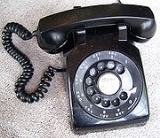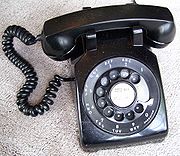
Pulse dialing
Encyclopedia

United Kingdom
The United Kingdom of Great Britain and Northern IrelandIn the United Kingdom and Dependencies, other languages have been officially recognised as legitimate autochthonous languages under the European Charter for Regional or Minority Languages...
(because up to 10 pulses are sent), is pulsing
Pulse (signal processing)
In signal processing, the term pulse has the following meanings:#A rapid, transient change in the amplitude of a signal from a baseline value to a higher or lower value, followed by a rapid return to the baseline value....
in which a direct-current pulse train is produced by interrupting a steady signal according to a fixed or formatted code
Code
A code is a rule for converting a piece of information into another form or representation , not necessarily of the same type....
for each digit and at a standard pulse repetition rate.
Dial pulsing originated with a rotary dial
Rotary dial
The rotary dial is a device mounted on or in a telephone or switchboard that is designed to send electrical pulses, known as pulse dialing, corresponding to the number dialed. The early form of the rotary dial used lugs on a finger plate instead of holes. Almon Brown Strowger filed the first patent...
integrated into telephone
Telephone
The telephone , colloquially referred to as a phone, is a telecommunications device that transmits and receives sounds, usually the human voice. Telephones are a point-to-point communication system whose most basic function is to allow two people separated by large distances to talk to each other...
instruments, for the purpose of signaling. Subsequent applications use electromechanical or electronic circuits to generate dial pulses.
The pulses are generated through the making and breaking of the telephone connection (akin to flicking a light switch on and off); the audible clicks are a side effect of this. As a result, all that is really needed to dial a number with pulse dialing is a switch. Each digit in the number is represented by a different number of rapid clicks. In most countries one click is used for the digit 1, two clicks for 2, and so on, with ten clicks for the digit 0; this makes the code unary
Unary numeral system
The unary numeral system is the bijective base-1 numeral system. It is the simplest numeral system to represent natural numbers: in order to represent a number N, an arbitrarily chosen symbol representing 1 is repeated N times. For example, using the symbol | , the number 6 is represented as ||||||...
, excepting the digit 0. Exceptions to this are New Zealand, with ten clicks for 0, nine clicks for 1, and so on; Sweden, with one click for 0, two clicks for 1, and so on; and in Oslo, the capital city of Norway, where the 'New Zealand' system was used in inverse to the rest of the country.
Individual digits in a phone number need to be separated with a short pause so as not to bleed into each other (originally, to give the rotary relays at the exchange time to rotate) and in keypad based pulse dialing digits need to be "buffered
Typeahead
Typeahead is a feature of computers and software that enables users to continue typing regardless of program or computer operation—the user may type in whatever speed he or she desires, and if the receiving software is busy at the time it will be called to handle this later...
" when dialed rapidly. In rotary systems this interdigit interval is provided by the slow rotation of the mechanical dial.
Pulse dialing replaced the two telegraph keys used by telephones connected to the original Strowger
Strowger switch
The Strowger switch, also known as Step-by-Step or SXS, is an early electromechanical telephone switching system invented by Almon Brown Strowger...
exchange to control its vertical and horizontal magnets. With the new system, rather than tap each telegraph key the correct number of times, the user first dialed the vertical number, and then the horizontal number. A slow-release relay detected the interval between the two pulse trains, later standardized to approximately half a second. Director telephone system
Director telephone system
The Director System was a system which made it possible to call subscribers at other telephone exchanges without operator intervention in large multi-exchange cities, and to have a mixture of automatic and manual exchanges within these cities...
s and panel switch
Panel switch
The panel switching system was an early type of automatic telephone exchange, first put into urban service by the Bell System in the 1920s and removed during the 1970s...
es had equipment to record and decode the digits, which earlier systems had used directly to drive the switches. Dial pulses were further standardized, with a percent break usually specified at approximately 66% and 10 pulses per second. Some telephone systems standardized at 20 PPS. With the spread of Stored Program Control exchange
Stored Program Control exchange
Stored Program Control exchange is the technical name used for telephone exchanges controlled by a computer program stored in the memory of the system. Early exchanges such as Strowger, panel, rotary, and crossbar switches were electromechanical and had no software control...
s in the 1970s, pulse counting became a software job.
Most fixed-line phones now use dual tone multi frequency (DTMF, also called touch tone or tone dialing), supported by push-button telephone
Push-button telephone
The push-button telephone was first invented in 1941, and is a telephone with push-buttons or keys, and which eventually replaced rotary dial telephones that were first used in 1891. The first push-button telephone was invented in the labs of Bell Telephone; however, these models were only...
s, rather than pulse dialing, but most telephone equipment retains support for pulse dialing for backward compatibility
Backward compatibility
In the context of telecommunications and computing, a device or technology is said to be backward or downward compatible if it can work with input generated by an older device...
. Some models of keypad phones have a tone/pulse switch which can be toggled to switch between the two, making these phones usable in areas where DTMF dialing is not accepted.
Tapping
It is possible to trick a phone system into thinking that a rotary dial is being used. To do this, one finds the little button, switch, or hook that is pushed down when the handset is hung up. The switch is then tapped the corresponding number of times at approximately ten taps per second to "dial" the corresponding number (i.e. 1 tap for the digit 1, 2 quick taps for the digit 2, and so on. The pulse dialing rules of Oslo, Norway and New Zealand are an exception; see above). This method can be used when the standard keypad or rotary dial cannot be used although the chances of dialing the wrong number are higher.In the UK
United Kingdom
The United Kingdom of Great Britain and Northern IrelandIn the United Kingdom and Dependencies, other languages have been officially recognised as legitimate autochthonous languages under the European Charter for Regional or Minority Languages...
it used to be possible to make calls free of charge from coin-box phones (payphone
Payphone
A payphone or pay phone is a public telephone, often located in a phone booth or a privacy hood, with pre-payment by inserting money , a credit or debit card, or a telephone card....
s) by tapping the switch-hook. A person caught tapping could be charged with 'abstracting electricity' from the GPO
General Post Office
General Post Office is the name of the British postal system from 1660 until 1969.General Post Office may also refer to:* General Post Office, Perth* General Post Office, Sydney* General Post Office, Melbourne* General Post Office, Brisbane...
(several cases of dishonestly using telephones without paying were prosecuted under this offense). As the coin-box dial was designed so that toll (0) and emergency service (999) calls could be made without inserting coins, it was possible to dial the digits "0" and "9" without tapping the switch-hook.
In popular culture, tapping was used in the film Red Dragon
Red Dragon (film)
Red Dragon is a 2002 thriller film based on Thomas Harris' novel of the same name and featuring psychiatrist and serial killer Dr. Hannibal Lecter. It is a prequel to The Silence of the Lambs....
as a way for prisoner Hannibal Lecter
Hannibal Lecter
Hannibal Lecter M.D. is a fictional character in a series of horror novels by Thomas Harris and in the films adapted from them.Lecter was introduced in the 1981 thriller novel Red Dragon as a brilliant psychiatrist and cannibalistic serial killer...
to dial out and circumvent a phone with no dialing mechanism. This method was also used by the character 'Phantom Phreak' to call 'Acid Burn' when taken to prison in the film Hackers
Hackers (film)
Hackers is a 1995 American thriller film directed by Iain Softley and starring Angelina Jolie, Jonny Lee Miller, Renoly Santiago, Matthew Lillard, Lorraine Bracco and Fisher Stevens...
.
Phone locks were sold to prevent unauthorized use of telephones. These attached to the rotary dial and prevented rotation. Tapping was difficult, but not impossible, on standard phones, because the line switch had a slow return characteristic, designed to stop it from accidentally dialing when the handset was not sitting correctly in seat, and to stop it accidentally being triggered when a call was in progress. After the national phone systems were deregulated in many countries, cheaper handsets became available and these cheaper handsets often did not have the slow-return characteristic on the line switch.
See also
- Federal Standard 1037CFederal Standard 1037CFederal Standard 1037C, titled Telecommunications: Glossary of Telecommunication Terms is a United States Federal Standard, issued by the General Services Administration pursuant to the Federal Property and Administrative Services Act of 1949, as amended....
- Dual-tone multi-frequencyDual-tone multi-frequencyDual-tone multi-frequency signaling is used for telecommunication signaling over analog telephone lines in the voice-frequency band between telephone handsets and other communications devices and the switching center. The version of DTMF that is used in push-button telephones for tone dialing is...
(DTMF) aka 'touch-tone' - Push-button telephonePush-button telephoneThe push-button telephone was first invented in 1941, and is a telephone with push-buttons or keys, and which eventually replaced rotary dial telephones that were first used in 1891. The first push-button telephone was invented in the labs of Bell Telephone; however, these models were only...

